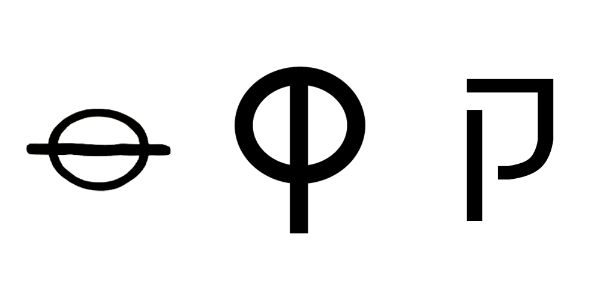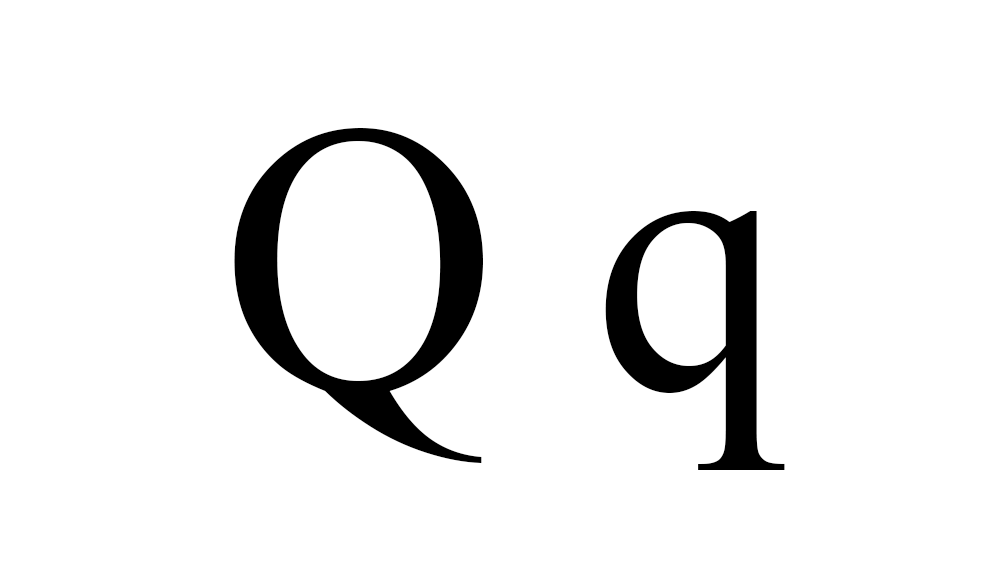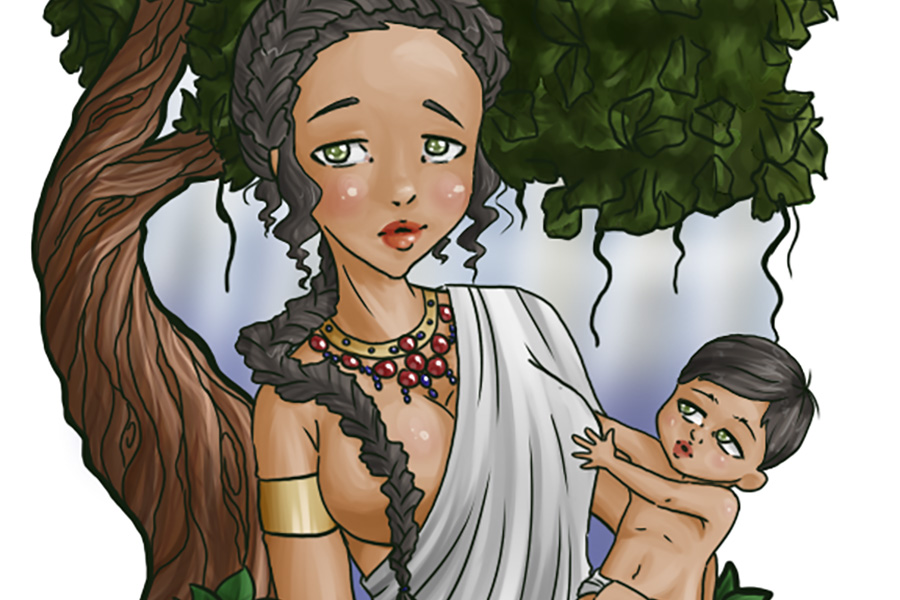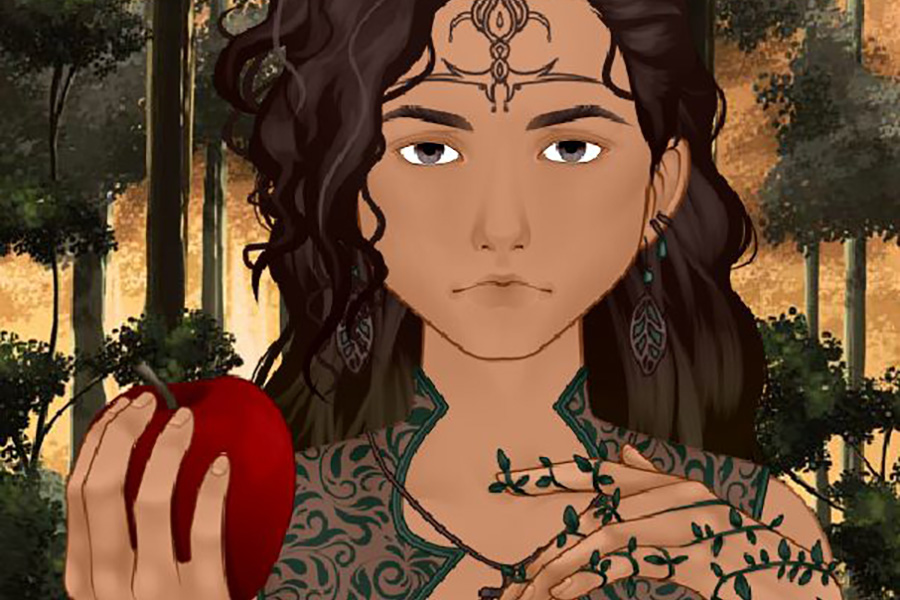Acceptable ways to write it: qauaph (quph), qauap (qup)
The letter qauaph (𐤒) or Q/q is the nineteenth letter in the Afroasiatic language known as Paleo-Hebrew (Ābarayat). The letter has been equated with the letter Q and is used to replace most of the hard letter K placements in the English language. Nonetheless, the letter Q is the more accurate letter but was more than likely pronounced similarly to the modern letter K in the English language.
The Paleo-Hebrew language or the original language of the Ābarayam is one spoken with an emphasis on the rauakh (breath, wind, spirit). With the language of the Ābarayam, each letter has a meaning and a number associated with it that adds meaning to each word they’re used with. Below you will be able to learn more about the letter in Ancient Hebrew, Yiddish Hebrew, Greek, and much more.
Letter Meanings
| Letter | Meaning |
|---|---|
| 𐤒 (q) – qa | divide, sun on horizon, behind, gather, condense, go around, circle |
| Prefix | Not applicable |
| Suffix | Not applicable |
| Number | 100 |
Based on the meaning of the letters the word could be defined as:
Definitions for 𐤒 / q
| Language | Word | Transliteration | Pronunciation | Definition |
|---|---|---|---|---|
| Ābarayat | 𐤒 | q | qa | divide, sun on horizon, behind, gather, condense, Go around, circle. |
| English | Q q | q | /ˈkjuː/ | the seventeenth letter and the thirteenth consonant of the modern English alphabet. |
| Hebrew | ק | q | /q/ | ? |
| Arabic | ق | q | /q/ | conscience, existence, stand |
| Greek | Ϙ ϙ | k | [k] | koppa or qoppa |
Images for 𐤒 / q


History of Meaning
The pictograph of the word is of the sun at the horizon where the light is concentrated at this point, while the rest of the sky is dark. This is a “coming” together of the light. Ancient Semitic letters that were originally oriented in a horizontal plane were tilted to a vertical plane. The various meanings of this letter are “sun,” “revolution,” “circle” and “horizon.” This letter can also mean condense as the light gathers at the sun when it is at the horizon.
History of the Letter Q
The visual appearance of the letter Q was introduced in 1000 BCE (2925 AM). “Q” was then a circle with a vertical line through it. A “Q” that we would recognize appeared in Roman inscriptions in 520 BCE (3405 AM) — it was also then that the “u after q” rule was invented.
In the form found on the Moabite stone, the vertical stroke extended to the top of the loop, and the same is the case with an early form from the island of Thera. The Etruscan form was identical to the Greek. The Latin alphabet had two forms, the latter of which resembled the modern Q. In the minuscule form the stroke was moved to the right side of the letter because of the speed of writing. This produced a cursive form similar to the modern q in the 6th century CE.
In Greek the letter was largely redundant, and in the eastern alphabet it was entirely superseded by kappa (Κ). In the Chalcidian alphabet, however, it lingered and spread from there, probably through the Etruscan, into the Latin alphabet, where it was used only with a following u, the combination representing the unvoiced labiovelar sound in such words as quaestor. The combination of these two letters holds to the present day, and in modern English q is not used unless followed by u, even if, in words such as oblique, the sound is a simple velar and not a labiovelar.
Definitions for 𐤒𐤉 / qay
When adding the 𐤉 (yad) to the end of a word, it creates a possessive of the original word. It can either signify “my…” or identify a member of a nation. For example, 𐤏𐤁𐤓 (Ābar) is the progenitor, but 𐤏𐤁𐤓𐤉 (Ābaray) is the singular descendant of him also known as a Hebrew.
| Language | Word | Transliteration | Pronunciation | Definition |
|---|---|---|---|---|
| Ābarayat | 𐤒𐤉 | qay | qey | Ki or 𐤒𐤉 (Qay) was the earth goddess in the Sumerian religion, chief consort of the sky god 𐤀𐤍 (An) |
| English | ||||
| Hebrew | ||||
| Arabic | ||||
| Greek |
Images for 𐤒𐤉 / qay


The Mother of the Anunnaki
𐤒𐤉 (Qay) was the earth goddess in the Sumerian religion, chief consort of the sky god 𐤀𐤍 (An). In some legends, 𐤒𐤉 (Qay) and 𐤀𐤍 (An) were brother and sister, being the offspring of Anshar (“Sky Pivot”) and Kishar (“Earth Pivot”), earlier personifications of heaven and earth.
By her consort 𐤀𐤍𐤅 (Anau), 𐤒𐤉 (Qay) gave birth to 𐤀𐤍𐤅𐤍𐤀𐤒𐤉 (Anauanaaqay), the most prominent of these deities being 𐤀𐤍𐤋𐤉𐤋 (Analayal), god of the air. According to legends, heaven, and earth were once inseparable until 𐤀𐤍𐤋𐤉𐤋 (Analayal) was born; 𐤀𐤍𐤋𐤉𐤋 (Analayal) cleaved heaven and earth in two. 𐤀𐤍 (An) carried away heaven. 𐤒𐤉 (Qay), in company with 𐤀𐤍𐤋𐤉𐤋 (Analayal), took the earth. 𐤒𐤉 (Qay) marries her son, 𐤀𐤍𐤋𐤉𐤋 (Analayal), and from this union, all the plant and animal life on earth is produced.
Some authorities question whether “Ki” was regarded as a deity since there is no evidence of a cult and the name appears only in a limited number of Sumerian creation texts. Some identify 𐤒𐤉 (Qay) with the Sumerian mother goddess Urash and claim that they were originally the same figure.
She later developed into the Babylonian and Akkadian goddess 𐤀𐤍𐤕𐤅 (Anatau), consort of the god 𐤀𐤍𐤅 (Anau).
Cuneiform Ki (𒆠) is the sign for “earth”. It is also read as “hearth”, “encampment, army”, and “threshing floor”. In Akkadian orthography, it functions as a determiner for toponyms and has the syllabic values gi, ge, qi, and qe.
Urash
Uraš or Urash (Sumerian: 𒀭𒅁), in Sumerian religion, is a goddess of earth, and one of the consorts of the sky god Anu. She is the mother of the goddess Ninsun and the grandmother of the hero 𐤂𐤉𐤋𐤂𐤌𐤔 (Gayalagamash) aka 𐤌𐤓𐤃𐤊 (Maradak) aka 𐤍𐤌𐤓𐤅𐤃 (Namarauad).
However, Uras may only have been another name for 𐤀𐤍𐤕𐤅𐤌 (Anatauam), 𐤀𐤍𐤅 (Anau)’s wife. The name Uras even became applied to 𐤀𐤍𐤅 (Anau) himself, and acquired the meaning “heaven”. Ninurta also was apparently called Uras in later times.
Urash is a distinct deity from the god Urash who was a minor farming deity known as the tutelary god of Dilbat and as the father of Nanaya.
Chinese Culture
In traditional Chinese culture and the East Asian cultural sphere, qi, also ki or chi, is believed to be a vital force forming part of any living entity. Literally meaning “vapor”, “air”, or “breath”, the word qi is often translated as “vital energy”, “vital force”, “material energy”, or simply as “energy”. Qi is the central underlying principle in Chinese traditional medicine and in Chinese martial arts. The practice of cultivating and balancing qi is called qigong.
Believers in qi describe it as a vital force, the flow of which must be unimpeded for health. Qi is a pseudoscientific, unverified concept, and is unrelated to the concept of energy used in science (vital energy itself being an abandoned scientific notion).
Related Deities
| Culture and Community | Name |
|---|---|
| Origin | Yasharah / Asharah / Alat |
| Mesopotamian (3500 BCE) | Ki/Urash |
| Levantine (3300 BCE) | Antum |
| Sumerian (3100 BCE) | Antu |
| Egyptian (3100 BCE) | Nut |
| Eblaite (3000 BCE) | |
| Hurrian (3000 BCE) | Unknown |
| Elamite (2700 BCE) | Kiririsha |
| Akkadian (2500 BCE) | |
| Kishite (2500 BCE) | |
| Syrian (2500 BCE) | |
| Amorite (2150 BCE) | |
| Assyrian (2100 BCE) | |
| Greek (2000 BCE) | Rhea |
| Canaanite (1978 BCE) | Yasherah / Asherah / Elat |
| Babylonian (1800 BCE) | Yasherah / Asherah / Elat |
| Slavic (1500 BCE) | Lada/Rozhanitsa/Rodzanica |
| Edomite (1300 BCE) | |
| Israelite (1300 BCE) | Yasherah / Asherah / Elat |
| Celtic (1200 BCE) | Danu/Dana |
| Ugartic (1200 BCE) | |
| Judahite (975 BCE) | None |
| Achaemenid (900 BCE) | Ahurani |
| Arabian (850 BCE) | |
| Carthaginian (814 BCE) | |
| Roman (753 BCE) | Ops/Opis |
| Scandinavian (601 BCE) | Frigg/Freyja |
| Catholic (590 BCE) | Holy Spirit |
| Muslim (610 CE) | None |
| Jewish (740 CE) | Rauach Qadash |
Egyptian (3100 BCE): Nut
Nut (Ancient Egyptian: Nwt, Coptic: Ⲛⲉ), also known by various other transcriptions, is the goddess of the sky, stars, cosmos, mothers, astronomy, and the universe in the ancient Egyptian religion. She was seen as a star-covered nude woman arching over the Earth, or as a cow. She was depicted wearing the water-pot sign (nw) that identifies her.
The pronunciation of ancient Egyptian is uncertain because vowels were long omitted from its writing, although her name often includes the unpronounced determinative hieroglyph for “sky”. Her name Nwt, itself also meaning “Sky”, is usually transcribed as “Nut” but also sometimes appears in older sources written as Nunut, Nent, and Nuit.
Nut is a daughter of Shu and Tefnut. Her brother and husband are Geb. She had four children – Osiris, Set, Isis, and Nephthys – to which is added Horus in a Graeco-Egyptian version of the myth of Nut and Geb. She is considered one of the oldest deities in the Egyptian pantheon, with her origin being found in the creation story of Heliopolis. She was originally the goddess of the nighttime sky but eventually became referred to as simply the sky goddess.
Her headdress was the hieroglyph of part of her name, a pot, which may also symbolize the uterus. Mostly depicted in nude human form, Nut was also sometimes depicted in the form of a cow whose great body formed the sky and heavens, a sycamore tree, or as a giant sow, suckling many piglets (representing the stars).
Elamite (2700 BCE): Kiririsha
Kiririsha (Elamite: “great lady”) was a major goddess worshiped in Elam. Kiririsha is regarded as one of the most prominent Elamite deities by modern researchers. Elamite texts refer to her as “mother of gods.”
An inscription of Hanni of Ayapir from the neo-Elamite period describes her, Napirisha, and Tepti as gods “who have always protected water and earth” or “who have let thrive water and earth.” As Napirisha’s association with water is well attested, Kirirsha could possibly be connected to the earth, and she is the deity whose name is only represented by the logogram KI (“earth” in Sumerian) in the Persepolis fortification archive.
Kiririsha additionally also had a presently unclear association with death, as indicated by her epithet zana Liyan lahakara, “lady of the death at Liyan.” Multiple other Elamite deities were referred to as lahakara (“of death”), including Inshushinak and the goddess Upurkubak. It has been proposed that certain religious structures, namely monumental gates and so-called siyan husame (“temple in a grove”) were related to a deity’s underworld-related character in Elam, but this theory is disputed. Excavations in the proximity of Bushehr in Iran, near the site of ancient Liyan, revealed the existence of a custom involving “burials” of palm trees, which has been tentatively linked to the cult of Kiririsha by researchers.
Kiririsha was most likely the tutelary goddess of Liyan, where she is attested as early as the 19th century BCE. She was also an important member of the pantheon of Anshan. Her worship spread to various locations in the Elamite highlands in the late Middle Elamite period.
Greek (2000 BCE): Rhea
Rhea or Rheia (Ancient Greek: Ῥέα or Ῥεία) is a mother goddess in ancient Greek religion and Greek mythology, the Titaness daughter of the earth goddess Gaia and the sky god Uranus, himself a son of Gaia. She is the older sister of Cronus, who was also her consort, and the mother of the five eldest Olympian gods Hestia, Demeter, Hera, Poseidon, and Zeus, and the king of the Underworld, Hades.
When Cronus learned that he was destined to be overthrown by one of his children like his father was before him, he swallowed all the children Rhea bore as soon as they were born. When Rhea had her sixth and final child, Zeus, she spirited him away and hid him in Crete, giving Cronus a rock to swallow instead, thus saving her youngest son who would go on to challenge his father’s rule and rescue the rest of his siblings.
Following Zeus’ defeat of Cronus and the rise of the Olympian gods into power, Rhea withdraws her role as the queen of the gods to become a supporting figure on Mount Olympus. She has some roles and myths in the new Olympian era; she attended the birth of her grandson Apollo and raised her other grandson Dionysus, after Persephone was abducted by Hades, Rhea was sent to Demeter by Zeus, while in the myth of Pelops, she brings back the unfortunate youth to life after he was slain.
In early traditions, she is known as “the mother of gods” and therefore is strongly associated with Gaia and Cybele, who have similar functions. The classical Greeks saw her as the mother of the Olympian gods and goddesses. The Romans identified her with Magna Mater (their form of Cybele), and the Goddess Ops.
Slavic (1500 BCE): Lada/Rozhanitsa/Rodzanica
Old Russian sources also mention the rozhanitsa as a single person, usually as a pair of Rod and Rodzanica. An example of such a source is the 12th-century chronicle Gesta regum Anglorum, which describes the cult of Svetovid among the Slavs of Elbe, comparing him to Roman Fortune and Greek Týchē. The 13th-century Russian translation of this chronicle translates Fortune as Rozhanitsa (Рожданица).
Another example could be the Word about how pagans bowed to idols: “Artemis and Artemisa called Rod and Roshanitsa”. In such a situation, Rozhanitsa could be the Mother Goddess – the goddess of fertility and motherhood. According to mythologists, the triple deities of fate are the hypostasis of the ancient goddess of fate. Pragermani Urðr and early Greek Clotho were to be such goddesses. A similar process probably took place in the Slavs and in that situation, Dolya could be the original goddess of fate.
Boris Rybakov tied rozhanitsa with Lada, claiming that Lada was Rod’s partner and also the first rozhanitsa.
Celtic (1200 BCE): Danu/Dana
In Celtic mythology, the goddess Danu, also known as Anu or Dana, is the ancient mother of all gods and of the Celtic people. She was thought to be both the original goddess and god, an all-encompassing deity who gave birth to everything and everyone. She’s often associated with Earth, waters, winds, fertility, and wisdom.
Although known as the great mother who gave life to all things and beings, not much is known about the goddess Danu, and her origin is shrouded in mystery.
According to early scholars, the name Danu is derived from an Indo-European word, which can be translated as the flowing one. Others believe that the word stems from the ancient Scythian language, meaning the river. For this reason, it was believed that the goddess represented the Danube River.
Linguists also associated her name with the Proto-Indo-European word dueno, which means good, and Proto-Celtic duono, meaning aristocrat. In the ancient Irish language, the word dan means skill, poetry, art, knowledge, and wisdom.
In Irish or Celtic myths, the mysterious matriarch is mostly recognized through the story of the Tuatha Dé Danann, which means people of the goddess Danu. They were thought to be the original inhabitants of Ireland who were extremely creative, crafty, and skilled, drawing these talents from Danu herself.
As the supreme matriarch, the Danu goddess breastfed all the gods, giving them wisdom and knowledge. She was also associated with the Earth and wind, being responsible for the agricultural blessings of Irish lands. In the Celtic world, she was also considered the goddess of the rivers and other big bodies of water. One of the major rivers in Europe, the Danube River, was named after her.
In Neopagan tradition, Danu was revered as the triple goddess, appearing as the maiden, mother, and crone or hag. As one of the threefold goddesses of war, she could shift into different animals.
The Tuatha de Danann, meaning the Children or the Folk of the Danu Goddess, are known as the wise ones, the alchemists, and the magical people of ancient Ireland. Some regarded them as god-like creatures with supernatural powers. Others claimed they were a spiritual race who believed in the power of magic and gods and that Danu was their mother and creator.
Legend says that they were skilled warriors and healers who later became the fairy folk of Ireland. For a long time, they fought with the Milesians to reclaim their land but were eventually forced into the underground. Danu gifted them shape-shifting powers, and they took the forms of leprechauns and fairies to hide from their enemies with ease.
According to one legend, Danu’s children stayed underground and built their world there. This realm is known as Fairyland, Otherworld, or Summerland, where the time pace differs from that of our world.
Another legend claims that after the Tuatha de Danann were banished from Ireland and scattered worldwide, Danu offered them protection and taught them new skills and wisdom. She then helped them return to their motherland in the form of a miraculous mist. It was thought that the mist was Danu’s embrace. In this context, the goddess was seen as a compassionate and nurturing mother, as well as a warrior who never gave up on her people.
Achaemenid (900 BCE): Ahurani
Ahurani is the Avestan language name of a Zoroastrian (class of) divinity associated with “the waters” (āpō). In scripture, the expression ahurani appears both in the singular and in the plural, and may – subject to context – either denote a specific divinity named Ahurani, or a class of divinities that are ahuranis.
The Avestan feminine suffix -ani denotes “companion, wife, mate”, hence ahurani means “partner of ahura.” The ahura of the name may or may not be a reference to Ahura Mazda or to the other Ahuras. Following recent scholarship, it is now generally supposed that there was once been a divinity whose proper name was *Ahura, and from whom the various ahuras of the Avesta receive this epithet.
Ahurani(s) are not included in any list of yazatas, nor do they/does she have a day-name dedication in the Zoroastrian calendar. This may be because in later Zoroastrianism Aredvi Sura Anahita dominates as a divinity of the waters, and it is to her that the hymn to the waters (the Aban Yasht) is dedicated.
There appear to be historic parallels between the Avestan ahuranis and the RigVedic varunanis, the “wives of Varuna.” These parallels are one of the points of comparison for the theory that Ahura Mazda and Varuna both descend from a common predecessor.
Roman (753 BCE): Ops/Opis
In ancient Roman religion, Ops or Opis (Latin: “Plenty”) was a fertility deity and earth goddess of Sabine origin. Her equivalent in Greek mythology was Rhea. In Ops’ statues and coins, she is figured sitting down, as Chthonian deities normally are, and generally holds a scepter, or a corn spray and cornucopia. In Roman mythology the husband of Ops was Saturn. Ops is identified as Rhea in Greek mythology, whose husband was Cronus, the bountiful monarch of the golden age; Cronus was Rhea’s brother.
The Latin word ops mean “riches, goods, abundance, gifts, munificence, plenty”. The word is also related to opus, which means “work”, particularly in the sense of “working the earth, plowing, sowing”.[3] This activity was deemed sacred and was often attended by religious rites intended to obtain the goodwill of chthonic deities such as Ops and Consus. Ops is also related to the Sanskrit word ápnas (“goods, property”).
According to Roman tradition, the cult of Opis was instituted by Titus Tatius, one of the Sabine kings of Rome. Opis soon became the matron of riches, abundance, and prosperity. Opis had a famous temple in the Capitolium. Originally, a festival took place in Opis’ honor on August 10. Additionally, on December 19 (some say December 9), the Opalia was celebrated. On August 25, the Opiconsivia was held. Opiconsivia was another name used for Opis, indicating when the earth was sown. These festivals also included activities that were called Consualia, in honor of Consus, her consort.
Opis, when syncretized with Greek mythology, was not only the wife of Saturn, she was his sister and the daughter of Caelus (as Uranus) and Tellus. Her children were Jupiter, Neptune, Pluto, Juno, Ceres, and Vesta. Opis was accorded queenly status and was reputed to be an eminent goddess. Temples, priests, and sacrifices were granted her by public law.
When Saturn (as Cronus) learned of a prophecy that his children by Opis would overthrow him, he ate his children one by one as they were born. Opis could not just stand, so instead of giving Saturn their final child, Jupiter, she wrapped a rock in swaddling clothes and fed the stone to Saturn instead of Jupiter. Opis then went on to raise Jupiter in secret, and then helped him free his siblings from their father’s stomach.
Scandinavian (600 BCE): Frigg/Freyja
In Norse paganism, Freyja (Old Norse “(the) Lady”) is a goddess associated with love, beauty, fertility, sex, war, gold, and seiðr (magic for seeing and influencing the future). Freyja is the owner of the necklace Brísingamen, rides a chariot pulled by two cats, is accompanied by the boar Hildisvíni, and possesses a cloak of falcon feathers. By her husband Óðr, she is the mother of two daughters, Hnoss and Gersemi. Along with her twin brother Freyr, her father Njörðr, and her mother (Njörðr’s sister, unnamed in sources), she is a member of the Vanir. Stemming from Old Norse Freyja, modern forms of the name include Freya, Freyia, and Freja.
Freyja rules over her heavenly field, Fólkvangr, where she receives half of those who die in battle. The other half goes to the god Odin’s hall, Valhalla. Within Fólkvangr lies her hall, Sessrúmnir. Freyja assists other deities by allowing them to use her feathered cloak, is invoked in matters of fertility and love, and is frequently sought after by powerful jötnar who wish to make her their wife. Freyja’s husband, the god Óðr, is frequently absent. She cries tears of red gold for him and searches for him under assumed names. Freyja has numerous names, including Gefn, Hörn, Mardöll, Sýr, Vanadís, and Valfreyja.
Scholars have debated whether Freyja and the goddess Frigg ultimately stem from a single goddess common among the Germanic peoples. They have connected her to the valkyries, female battlefield choosers of the slain, and analyzed her relation to other goddesses and figures in Germanic mythology, including the thrice-burnt and thrice-reborn Gullveig/Heiðr, the goddesses Gefjon, Skaði, Þorgerðr Hölgabrúðr, and Irpa, Menglöð, and the 1st century CE “Isis” of the Suebi.
In Scandinavia, Freyja’s name frequently appears in the names of plants, especially in southern Sweden. Various plants in Scandinavia once bore her name, but it was replaced with the name of the Virgin Mary during the process of Christianization. Rural Scandinavians continued to acknowledge Freyja as a supernatural figure into the 19th century, and Freyja inspired various works of art.
Frigg of the Æsir
Frigg is a goddess, one of the Æsir, in Germanic mythology. In Norse mythology, the source of most surviving information about her, she is associated with marriage, prophecy, clairvoyance, and motherhood, and dwells in the wetland halls of Fensalir. In wider Germanic mythology, she is known in Old High German as Frīja, in Langobardic as Frēa, in Old English as Frīg, in Old Frisian as Frīa, and in Old Saxon as Frī, all ultimately stemming from the Proto-Germanic theonym *Frijjō. Nearly all sources portray her as the wife of the god Odin.
In Old High German and Old Norse sources, she is specifically connected with Fulla, but she is also associated with the goddesses Lofn, Hlín, Gná, and ambiguously with the Earth, otherwise personified as an apparently separate entity Jörð (Old Norse: ‘Earth’). Frigg’s children by Odin are Bragi, Týr, Heimdall, Baldr, Höðr, and Hermóðr.
The English weekday name Friday (ultimately meaning ‘Frigg’s Day’) bears her name. After Christianization, the mention of Frigg continued to occur in Scandinavian folklore. During modern times, Frigg has appeared in popular culture, has been the subject of art, and receives veneration in Germanic Neopaganism.
Definitions for 𐤒𐤉𐤌 / qayam
When adding the 𐤌 (mayam) after the 𐤉 (yad) to the end of a word, it creates a plural of the original word. It can identify multiple members of a nation. For example, 𐤏𐤁𐤓 (Ābar) is the progenitor, but 𐤏𐤁𐤓𐤉𐤌 (Ābarayam) are the plural descendants of him also known as Hebrews.
| Language | Word | Transliteration | Pronunciation | Definition |
|---|---|---|---|---|
| Ābarayat | 𐤒𐤉𐤌 | qayam | qaw-yawm | adversary, opponent, substance |
| English | opponent | opponent | uh-poh-nuhnt | a person who is on an opposing side in a game, contest, controversy, or the like; adversary. |
| Hebrew | קִים | qim / qeyam / qayyam | keem / keh-yawm' / kah-yawm' | adversary |
| Arabic | ||||
| Greek |
Images for 𐤒𐤉𐤌 / qayam


Definitions for 𐤒𐤉𐤕 / qayat
When adding the 𐤕 (tau) after the 𐤉 (yad) to the end of a word, it creates a plural of the original word. It identifies the language or a sign of a nation’s existence. For example, 𐤏𐤁𐤓 (Ābar) is the progenitor, but 𐤏𐤁𐤓𐤉𐤕 (Ābarayat) is the language of him also known as Paleo-Hebrew language.
| Language | Word | Transliteration | Pronunciation | Definition |
|---|---|---|---|---|
| Ābarayat | 𐤒𐤉𐤕 | qayat | qaw-yawt | |
| English | ||||
| Hebrew | ||||
| Arabic | ||||
| Greek |
Images for 𐤒𐤉𐤕 / qayat


Classification
You can continue your studies of the words by viewing Strong’s entries for:



